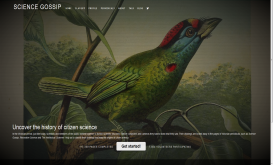When Darwin was developing his theories of evolution he read avidly in popular natural history magazines and sought out information from an army of almost 2,000 correspondents. Such engagement with a wide public in the construction of science became increasingly difficult with the development of professional, and highly specialized science, but the emergence of "citizen science" projects has suggested a new way forward. With the creation of vast data sets in contemporary science, there is a need for a new army of volunteers to help classify and analyze the information. The Zooniverse platform, started in 2007 with "Galaxy Zoo," now has over 800,000 participants who contribute to projects from astrophysics to climate science (www.zooniverse.org). Significant discoveries have already been made by these volunteers in the field of astronomy. Yet, the structures by which these volunteers might engage with professional science, and through which scientists themselves might draw upon their findings, are not clear, and researchers on the project have been turning to nineteenth-century models of communication to find ways of harnessing this huge popular interest in order to increase the rate of scientific progress.
The information revolution in our own age has parallels in the nineteenth century which saw an explosion of print, and journal publishing; in 1800 there were only around 100 science periodicals, but by 1900 this had jumped to 10,000 worldwide. The project brings together historical and literary research in the nineteenth century with contemporary scientific practice, looking at the ways in which patterns of popular communication and engagement in nineteenth-century science can offer models for current practice. The research is timely since the digital revolution, and open-access publishing, are about to change forever the processes and forms of scientific communication and exchange. In this project, which is funded by the AHRC, Sally Shuttleworth worked with a team of researchers in conjunction with Professor Gowan Dawson at the University of Leicester, Professor Chris Lintott, Department of Astrophysics at the University of Oxford, and three partner institutions: the Natural History Museum, London; the Royal College of Surgeons, London, and the Royal Society of London.

